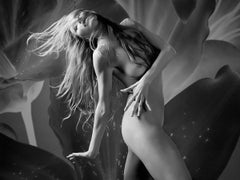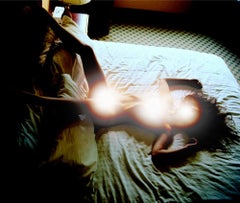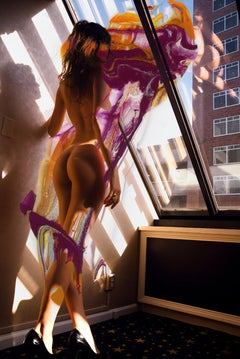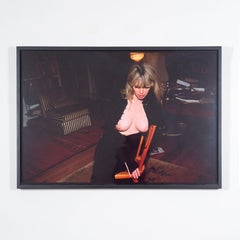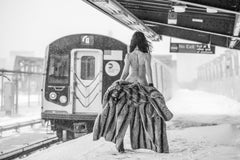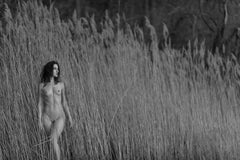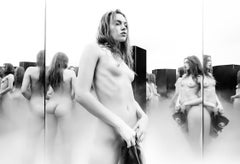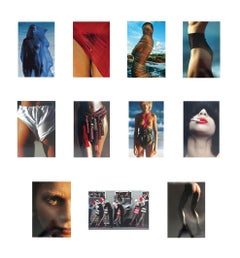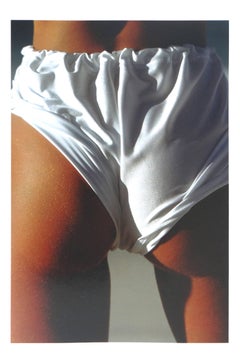Dye Transfer Nude Photography
to
10
2
2
6
11
2
3
2
1
1
6
Overall Height
to
Overall Width
to
13
10
6
3
3
3
3
2
2
2
2
2
2
1
1
1
1
1
1
1
1
4
9
2
1
1
6
2
1
1
1
446
2,434
2,294
2,260
1,590
Medium: Dye Transfer
"Goddess and Lilies No 3" Photography, Archival Ink on Aluminum, Figurative Nude
Located in New York, NY
Goddess Series featuring dancer Katherine Crockett
Dimensions: 9 x 12in (Limited Edition 2/15), 12 x 18in (Limited Edition 2/10)
This piece is sign...
Category
2010s Contemporary Dye Transfer Nude Photography
Materials
Metal
"Flashburn II" Photography, Dye Sublimation on Aluminum, Glossy Finish
Located in New York, NY
Limited Edition of 5
This piece is signed on verso, includes gallery label, and certificate of authenticity.
Leah Schrager is an artist who works between the web and New York City. She graduated in 2015 with an MFA in Fine Art from Parsons, The New School. In her work, she photographs, appears in, augments and markets her own image. She is interested in the line, movement and, biography of the female body. In 2010, she founded a new form of therapy as Sarah White, The Naked Therapist, followed by online performance @OnaArtist (Instagram 3 million+). Her project, “Ona,” an artist and musician, evolved out of the question of celebrity as art practice. With her performances, Schrager explores themes of sexuality, representation, and distribution. Her practice is situated in a contemporary hotbed of female (in)appropriateness, arousal, celebrity, fandom, and commercialism that seeks to explore female biography and labor in today’s global society. Schrager has been compared by journalists to such seminal figures as Marina Abramovic, Marcel Duchamp, Laurel Nakadate, Diane Fossey, and Sigmund Freud. She and/or her work has been profiled in 1000′s of media outlets, including Art Forum, Monopol, The Huffington Post, Vice, Viceland, The Tonight Show...
Category
2010s Contemporary Dye Transfer Nude Photography
Materials
Metal
"Clothed in May" Photography, Dye Sublimation on Aluminum, Glossy Finish
Located in New York, NY
Limited Edition of 5
This piece is signed on verso, includes gallery label, and certificate of authenticity.
Leah Schrager is an artist who works between the web and New York City. She graduated in 2015 with an MFA in Fine Art from Parsons, The New School. In her work, she photographs, appears in, augments and markets her own image. She is interested in the line, movement and, biography of the female body. In 2010, she founded a new form of therapy as Sarah White, The Naked Therapist, followed by online performance @OnaArtist (Instagram 3 million+). Her project, “Ona,” an artist and musician, evolved out of the question of celebrity as art practice. With her performances, Schrager explores themes of sexuality, representation, and distribution. Her practice is situated in a contemporary hotbed of female (in)appropriateness, arousal, celebrity, fandom, and commercialism that seeks to explore female biography and labor in today’s global society. Schrager has been compared by journalists to such seminal figures as Marina Abramovic, Marcel Duchamp, Laurel Nakadate, Diane Fossey, and Sigmund Freud. She and/or her work has been profiled in 1000′s of media outlets, including Art Forum, Monopol, The Huffington Post, Vice, Viceland, The Tonight Show...
Category
2010s Contemporary Dye Transfer Nude Photography
Materials
Metal
Joey with Her New Breasts (NYC)
By Nan Goldin
Located in Toronto, Ontario
Nan Goldin (b. 1953) is one of the most influential photographers of the 20th century. Beginning in the 1970's Goldin took candid shots of her lovers and friends - especially drag queens and trans women, characters often living on the margins of society, in New York City and beyond.
"Cody in the Dressing Room at the Boy Bar, NYC” is a paradigm of Goldin's work from the early 1990’s celebrating both nightlife and its beautiful denizens.
The photograph shows Cody, semi-nude and confidently posing for Goldin, as they either unwind after or are preparing for a performance. Situated in a dressing room signalled by the mirror, makeup and clothes strewn around. Behind Cody is a silver grid of black and white portraits taped to the wall, reminiscent of Warhol’s famous screen tests, and a reminder of Goldin's exceptional composition. Furthermore, the image is cropped right above the subject's waist leaving their actual gender ambiguous if not irrelevant.
Today, images of drag queens and glamorous trans woman are increasingly common in Western culture, considering the success of TV shows such as Rupaul's Drag Race...
Category
1990s Contemporary Dye Transfer Nude Photography
Materials
Dye Transfer
"Missed Connection"- Black & White Nude Photo, Brooklyn, NY
By John Mazlish
Located in Brooklyn, NY
Shot in Brooklyn on an elevated subway platform during a snowstorm in 17 degree weather. Sometimes ya just gotta go for it!
Fine art photo mounted on di-bond aluminum. Custom print...
Category
2010s Contemporary Dye Transfer Nude Photography
Materials
Metal
Woman in Reeds
By John Mazlish
Located in Brooklyn, NY
Shot amongst cattails on Long Island, NY.
Fine art photo mounted on di-bond aluminum. Custom printing/mounting/framing options available upon request.
Category
2010s Contemporary Dye Transfer Nude Photography
Materials
Metal
"Torso in Reeds"- Black & White Abstract Nude in Nature
By John Mazlish
Located in Brooklyn, NY
Abstract view of the female body, shot amongst the cattails in Long Island, NY.
Fine art photo mounted on di-bond aluminum. Custom printing/mounting/framing options available upon r...
Category
2010s Contemporary Dye Transfer Nude Photography
Materials
Metal
"Edge of the World"- Black & White Photo, Sensual Silhouette, Holbox, Mexico
By John Mazlish
Located in Brooklyn, NY
Dusk on the island of Holbox, Mexico.
Fine art photo mounted on di-bond aluminum. Custom printing/mounting/framing options available upon request.
Category
2010s Contemporary Dye Transfer Nude Photography
Materials
Metal
"Day Is Done"- Black & White Silhouette, Sensual Photo, Holbox, Mexico
By John Mazlish
Located in Brooklyn, NY
Shot on Holbox Island, Mexico.
Fine art photo mounted on di-bond aluminum. Custom printing/mounting/framing options available upon request.
Category
2010s Contemporary Dye Transfer Nude Photography
Materials
Metal
"Suspended"- Colorful Nude in Water Photo
By John Mazlish
Located in Brooklyn, NY
Shot in a cenote in Tulum, Mexico.
Fine art photo mounted on di-bond aluminum. Custom printing/mounting/framing options available upon request.
Category
2010s Contemporary Dye Transfer Nude Photography
Materials
Metal
Dye Transfer Study
Located in Roma, IT
Dye Transfer Study in an original artwork realized by Robert Graham in 1970. It is in silver print photographic contact sheet and handcolored with pink ac...
Category
1970s Contemporary Dye Transfer Nude Photography
Materials
Dye Transfer
Dye Transfer Study
Located in Roma, IT
Dye Transfer Study is an original artwork realized by Robert Graham in 1970. It is a silver print photographic contact sheet, handcolored with pink acryli...
Category
1970s Contemporary Dye Transfer Nude Photography
Materials
Dye Transfer
Chicken Ranch Parlor, Pahrump Nevada, documentary-style dye transfer print, 1986
Located in New York, NY
Timothy Hursley was born in 1955 in Detroit, Michigan, where he apprenticed in architectural photography with Hungarian photographer Balthazar Korab beginning in 1972. His apprenticeship continued until he moved to Little Rock, Arkansas in 1980, where he started his own studio, The Arkansas Office.
From 1982 to 1987, Hursley made architectural photographs in New York of Andy Warhol’s last Factory on Madison Avenue at 34th Street. Eleven of Hursley's Factory photographs...
Category
1980s Contemporary Dye Transfer Nude Photography
Materials
Dye Transfer
Related Items
Invacuo Project #21. B&W Portrait inspired by the Gezi Park resistance movement
By Koray Erkaya
Located in Miami Beach, FL
Invacuo Project #21, 2016 by Koray Erkaya
From the series of Invacuo Project
Hahnemühle Photo Matt Fibre Duo 210
Image size: 16 in. H x 24 in. W (40 cm H x 60 cm W)
Edition of 10
Work is also available framed at an additional cost.
All sizes signed, titled, dated, and numbered on artist label verso
All Prices are quoted as "initial price". Please note that prices and availability may change due to current sales.
_____________________
JAZZ AND GAS
Joyful humour characteristic of the pro-democracy environmentalist Gezi Park protests in June 2013. People of all ages, students, writers, artists, actors, musicians, LGBT activists, Anti-Capitalist Muslims, Marxists, Anarchists, Kurdish and Turkish nationalists were peacefully together in the heart of modern Istanbul: Taksim Square. Then the police attacked with tear gas and their usual equipment. But if they use uneven brutal force, then we use uneven intelligence and creativity: “We are fair: Their gas is fresh air.” Such sarcastic slogans multiplied echoing the positive, hopeful, unyielding and determined character of the our jazz like plural harmony.
If Sultanahmet Square is the heart of Classical Istanbul with its Byzantine and Ottoman heritage, Taksim Square represents the modern city: the central statue representing the national liberation war and the formation of the Turkish Republic, Gezi Park, Ataturk Cultural Centre, big hotels, and the historic Istiklal (Independence) Street. Eyes shed tears not only because we laughed due to high quality satirical slogans but also because of the harmful gas and the deaths of several youngsters. Numerous citizens lost an eye or arm. Thanks to international media coverage, the inspiring Gezi Park resistance (or “June Movement”) in Turkey drew attention all over the world -while the pro-government media kept silent. Whether on purpose or not, tear gas –and its canisters at close range- took several lives. Don’t let anybody fool you: Tear gas may kill. And it did. Though “as a nation” we had been used to gas in previous demonstrations, one point was unique: The whole city was gassed. Babies, old people and citizens with asthma suffered in their homes. Before the police attack, maybe most of the young protesters were “merely” environmentalists without a major political orientation. Tear gas brutality transformed most of them into political activists. Since that June, our lungs, souls and future have been full of that gas. Tear gas has been used not only in Turkey but in many other countries as well –since the 1990s. We tend to think that “Every soul shall taste it,” –sounding like a statement from a holy book. The situation is unacceptable: A child on the way to get bread for breakfast may die –in fact be killed by the police using tear gas without proper concern and care. Tear gas is a chemical weapon. It’s vital to comprehend that. The marketing is well-phrased but misleading: “Made from fruit and vegetables, wholly organic.” But when it is used at close range, its metal canister becomes a bullet. Fifty years ago, in late 1960s, 90 countries signed a petition against the usage of tear gas. Our country signed the 1997 Convention on Chemical Weapons, which states that tear gas is considered to be a chemical weapon when it is used in closed places, at close range or in a crowd. Despite this, it has been used time and again in Brasil, Chile,
Egypt, Germany, Gaza, Iraq, Ireland, Israel, Panama, the Philippines, South Korea, UK, USA, and Vietnam. The Association of Turkish Medical Doctors and the Initiative Against Tear Gas have been working and reacting diligently on this issue. “But the label says it’s harmless,” say some. But the firms that produce gas bombs put labels according to the demands of governments. Are you Shocked? Global trade has priority over humanitarian concern. But why this introduction? Don’t we all know all these things? We certainly do, but the “agenda” changes so fast that our knowledge does not find time to unite with our action in order to change the ongoing chain of events. Enter arts. With the mission of contributing to collective memory, Artist Koray Erkaya creatively documents experience. In his new photographic art series, Erkaya revolts against individual and social de-sensitivisation. In order to address the memory and to increase awareness, he uses “gas” against everyone –without discrimination. He tests his models with gas in the specifically prepared labyrinth made of mirrors. But of course, the gas he uses is not one of the types of tear gas labeled OC, CS or CN. In any case, the violence the people suffer is not limited to the content of the gas. When he started his voyage to display the violence, loneliness, nakedness, helplessness, spiritual and physical isolation of women, children, gays, transsexuals -all the humiliated people under some form of gas, Erkaya began working with models from various nations in Istanbul. Now he is on his way to show that this issue is a problem for all who live on the same planet. When we see ourselves in the eyes of the models in the mirrors...
Category
2010s Contemporary Dye Transfer Nude Photography
Materials
Metal
Under - underwater black & white nude photograph - print on aluminum 36x53"
By Alex Sher
Located in Beverly Hills, CA
An underwater black and white photograph of a young naked woman in a pool.
Original digital print on aluminum plate signed by the artist.
Limited edition of 12. Print #2
The artwo...
Category
2010s Contemporary Dye Transfer Nude Photography
Materials
Metal
H 36 in W 53 in D 0.01 in
Silver Gelatin print, Contemporary signed limited edition nude photo, Lisa
Located in Barcelona, Barcelona
‘ Lisa ' By Ian Sanderson, Silver Gelatin print, Fiber based
Photography : 1989
A beautiful silver gelatin fibre based print produced in the darkroom directly from the negative. The ...
Category
1980s Contemporary Dye Transfer Nude Photography
Materials
Silver
Free Shipping
H 15 in W 11 in D 0.02 in
Steps - underwater photograph - print on aluminum 12 x 10"
By Alex Sher
Located in Beverly Hills, CA
A light and very becoming underwater photograph of a girl walking down the steps in pool toward you. The light blue photograph shows no swimsuit neither any places where you would ex...
Category
2010s Contemporary Dye Transfer Nude Photography
Materials
Metal
Catherine Zeta-Jones (Limited Edition of 25) - Celebrity Photography
Located in New York, NY
This 1991 fine art print features Catherine Zeta-Jones when she was a TV actress in Britain and aspiring to be a Hollywood Star. Her success in The Darling Buds of May (English comed...
Category
1990s Contemporary Dye Transfer Nude Photography
Materials
Silver Gelatin
Free Shipping
H 30 in W 20 in
"Kate Moss Nr. 10" Photography 58 × 53 1/2 in Edition 1/1 by Kate Garner
By Kate Garner
Located in Culver City, CA
"Kate Moss Nr. 10" Photography 58 × 53 1/2 in Edition 1/1 by Kate Garner
Signed on the back.
High Quality Print on Hahnemuhle paper using archival ink with blue and pink tint, stre...
Category
21st Century and Contemporary Contemporary Dye Transfer Nude Photography
Materials
Stretcher Bars, Archival Ink, Archival Paper
Jane March (Limited Edition of 25) - 30"x40" Celebrity Photography
Located in New York, NY
This fine art print features actress and model Jane March, posed topless on the rooftop of the Hotel Le Bristol in Paris in 1992. This risqué iconic b...
Category
1990s Contemporary Dye Transfer Nude Photography
Materials
Silver Gelatin
Free Shipping
H 40 in W 30 in
Circus - underwater nude photograph - print on aluminum 26x36"
By Alex Sher
Located in Beverly Hills, CA
An underwater photograph of a topless young woman dancing on dark blue background.
Original digital print on aluminum plate signed by the artist.
Limited edition of 12
The artwork ...
Category
2010s Contemporary Dye Transfer Nude Photography
Materials
Metal
H 26 in W 36 in D 0.5 in
"Remembering Frida Kahlo" 26"x21"inch Ed 1/3 by VLADIMIR CLAVIJO-TELEPNEV
Located in Culver City, CA
"Remembering Frida Kahlo" 26"x21"inch Ed 1/3 by VLADIMIR CLAVIJO-TELEPNEV
Eglomise (bromoil gelatin silver print, gold and silver leaf, and hand painted mirror)
Vladimir Clavijo-Telepnev was born in 1962 in Moscow, in the family of creative people. His father, Pedro Clavijo, was a Columbian journalist and a radio reporter. His grandfather by his father's side, Edmundo Clavijo Cubilios, was a famous Columbia's photograph and artist. His grandfather and grandmother by his mother's side, Vladimir and Margarita Telepnevs, were painters.
In 1986 Vladimir graduated from the Moscow Polygraphic Academy, faculty of graphic art, specializing in painting, graphics, and polygraphic design.
PRIVATE COLLECTIONS:
ELTON JOHN
PRINCESS MICHAEL of KENT MARIE CHRISTINE
PETER GREENAWAY
DMITRY MEDVEDEV
NURSULTAN NAZARBAEV
Vladimir's work of arts were put up for auction at PHILLIPS de Pury in 2003 in New York, in 2008 in London and New York, in 2010 in New York; at GENE SHAPIRO in 2008, 2009, 2010, 2011 in New York and at HERITAGE AUCTIONS in 2011 in New York.
EXHIBITIONS:
2013
Group exhibition at the Gulbenkian Foundation, Lisbon, Portugal;
Solo exhibition at the AZOR ROZA Gallery, Moscow, Russia.
2012
Group exhibition of the best iconography for Lewis Carroll's "Alice", "A Mad Tea-Party", The Story Museum, Oxford, UK;
Group exhibition "Museum's Centenary: a Photographer's View" at the Pushkin Fine Arts Museum;
Solo exhibition at the ZEPPELIN Gallery, Moscow, Russia.
2011
Group exhibition at the ART MOSCOW FAIR.
2010
Pushkin Fine Arts Museum opened a section of photography with the participation of Vladimir Clavijo-Telepnev, the only Russian exhibitor.
2009
"Wayfaring Territory" group exhibition, St. Petersburg, Peter-and-Paul Fortress, Russia.
2008
"Joyance Territory" group exhibition in the Rumyantsev villa, St. Petersburg, Pskov, Belostok, Voronezh, Mikhailovskoye (all in Russia), and also in Berlin, Germany;
Solo exhibition at the VINZAVOD Exhibition Center.
2007
Solo exhibition at the MILLIONAIRE FAIR, Moscow, Russia;
Participation at the Moscow Fine Art Fair, MANEZH Exhibition Center.
2006
Art London, "Russian Asia", a joint project of Inna Khegai and the Artek Gallery, London, UK;
Solo exhibition at the ESPECRTO Gallery in Krasnodar.
2005
Personal exhibition within the framework of the Russian Movie Week in Paris, Paris-Art-Moscow, Espace Cardin, Paris;
personal exhibition at the MILLIONAIRE FAIR, Moscow;
exhibition at the Grossman Gallery, Williams Visual Arts Buildings, Easton, Penn;
personal exhibition at the Grand Hayat Hotel gallery, Dubai, Arab Emirates;
exhibition at the STUDIO Gallery, Moscow Russia;
exhibition of the Cherry Orchard project jointly with his student, Yulia Bochkova at the JAMES Gallery, Moscow;
the Moscow Romanticism exhibition at the Wisconsin University Art Gallery, U.S;
exhibition at the Tomsk House of Artists, Russia.2005: exhibition at the Benshaeb art gallery, Paris, France;
2004
Exhibition at the STUDIO Gallery, Moscow, Russia;
Exhibition at the LEAGUE Art Gallery, Kolomna, Russia;
Exhibition at the Krasnoyarsk Museum Center, Russia.2004: exhibition at Art-Service Gallery Center, Moscow, Russia;
Exhibition at the Novosibirsk Art Museum, Russia;
Exhibition at the Benshaeb art gallery, Paris, France;
Exhibition at the HAY HILL gallery, London, U.K.2004: exhibition within the framework of the Russian Nights festival at the Art Hall of the Pacific Design Center, Los Angeles, California.
2003
Russian Post Modernism Nostalgia exhibition, New York, U.S;
Exhibition at the LUMIERE, Moscow, Russia;
Exhibition at the Russian Modern History State Central Museum;
A participant at the 40 Views as to the Image of Comme de Garcon art...
Category
21st Century and Contemporary Contemporary Dye Transfer Nude Photography
Materials
Gold Leaf
On the Sofa at the Real Dolls Factory, San Diego, 19 February 2015
Located in New York, NY
On the Sofa at the Real Dolls Factory, San Diego, 19 February 2015
Photographed by Jonathan Becker
Contemporary
44" x 44.5" Archival Pigment Print
Edition Nº 1 of 9
Certificate of O...
Category
2010s Contemporary Dye Transfer Nude Photography
Materials
Archival Pigment
Slow Motion - underwater nude photo - print on aluminum 12 x 8"
By Alex Sher
Located in Beverly Hills, CA
Underwater black and white photograph of a naked young woman in a pool.
Original digital print on aluminum plate with black backboard - signed by the artist.
The artwork needs no a...
Category
2010s Contemporary Dye Transfer Nude Photography
Materials
Metal
H 12 in W 8 in D 0.5 in
Marble Cave - underwater nude photo - print on aluminum 12 x 8"
By Alex Sher
Located in Beverly Hills, CA
Underwater black and white photograph of a naked young woman in a pool.
Original digital print on aluminum plate with black backboard - signed by the artist.
The artwork needs no a...
Category
2010s Contemporary Dye Transfer Nude Photography
Materials
Metal
H 12 in W 8 in D 0.5 in
Previously Available Items
Hans Feurer. A Set of 11 Dye Transfer Prints
By Hans Feurer
Located in Miami Beach, FL
Hans Feurer curated a Set of 11 Dye Transfer Prints
order
1- "Pentax Calendar", 77/78
2- "Pentax Calendar", 77/78
3- "Pentax Calendar" 77/78
4- "FRZ. Elle", 86
5- "FRZ. Elle", 85
6- "NOVA/TWEN," 69/70
7- Mintex Calendar 82
8- "Queen Cover...
Category
20th Century Contemporary Dye Transfer Nude Photography
Materials
Color, Dye Transfer, Archival Pigment
FRZ. Elle Macpheson, Signed, Titled and Dated in Pencil on Verso
By Hans Feurer
Located in Miami Beach, FL
FRZ. Elie, 1985 by Hans Feurer
Dye Transfer Print
Unframed
Image size: 16.75 in. H x 11 in. W
Sheet size: 22.25 in H. x 19.25 H
Stamped "Photo Hans Feurer", signed, titled and date...
Category
20th Century Contemporary Dye Transfer Nude Photography
Materials
Color, Dye Transfer, Archival Pigment
H 22.25 in W 19.25 in D 0.1 in
Jane #5
By Anna Sweet
Located in Fort Lauderdale, FL
5 of 50. Dye sublimation print overlaid with resin, minerals, glow pigment and diamond.
Category
2010s Feminist Dye Transfer Nude Photography
Materials
Dye Transfer
Hans Feurer Curated Set of 11 Dye Transfer Prints
By Hans Feurer
Located in Miami Beach, FL
Hans Feurer curated set of 11 Dye Transfer Prints
order
1-2-3-4.
5-6-7-8.
9-10-11.
Unframed
Individual image size: 16.75 in. H x 11 in. W
Individual shee...
Category
20th Century Contemporary Dye Transfer Nude Photography
Materials
Color, Dye Transfer, Archival Pigment
Michele, Dye Transfer Print, Framed, 1983
By Frank Horvat
Located in Miami Beach, FL
Michele, 1983 by Frank Horvat
Dye Transfer Print
Image size: 14 in. H x 9.38 in. W
Sheet size: 22.63 in. H x 19.5 in. W
Frame size: 31 in. H x 26 in. W
Signed, titled and dated in pencil on verso.
Framed
____________________________________
Frank Horvat (28 April 1928 – 21 October 2020) was an Italian photographer who lived and worked in France. He is best known for his fashion photography, published between the mid 1950s and the late 1980s. Horvat’s photographic opus includes photojournalism, portraiture, landscape, nature, and sculpture. He was the recipient of the Fondazione del Centenario Award in 2010 for his contributions to European culture.
He has collaborated with fellow photographers such as Don McCullin, Robert Doisneau, Sarah Moon, Helmut Newton, and Marc Riboud. In the 1990s, he was one of the first major photographers to experiment with technology including photoshop.
Horvat was born in Abbazia, Italy (now Opatija, Croatia), on 28 April 1928, into a Jewish family from Central Europe. His father, Karl, was a Hungarian general physician, and his mother, Adele, was a psychiatrist from Vienna. At the age of 11, in 1939, his family moved to Lugano in Switzerland, fleeing fascism in Italy. He went on to study fine art at Brera Academy in Milan. Horvat lived in several countries including Switzerland, Italy, Pakistan, India, England, and America) before settling in France in 1955.
Horvat started his career in the mid 1950s as a photojournalist in Paris, working to capture the ‘sleaze and squalor’ of the city, before going on to fashion photography. He acknowledged having been strongly influenced by French humanist photographer Henri Cartier-Bresson. After meeting him in 1950, he followed his advice and replaced his Rollei with a Leica camera and embarked on a two-year journey through Asia as a free-lance photojournalist. His photographs from this trip were published by Life, Réalités, Match, Picture Post, Die Woche, and Revue. His photograph of an Indian bride under a veil, her face reflected in a mirror on her lap, was selected by Edward Steichen for The Family of Man exhibit at the Museum of Modern Art which toured the world to be seen by 9 million visitors.
In 1955, Horvat moved from London to Paris and found that the mood of its streets and its inhabitants had little in common with the somewhat romantic vision of the so-called humanist photographers. In 1957, Horvat shot fashion photographs for Jardin des Modes using a 35-mm camera and available light, which formerly had rarely been used for fashion. This innovation was welcomed by ready-to-wear designers, because it presented their creations in the context of everyday life. In the following years, Horvat was commissioned to do similar work for Elle in Paris, Vogue in London, and Harper’s Bazaar in New York.
Between 1962 and 1963, Horvat turned to photojournalism and took a trip around the world for the German magazine Revue. Then he experimented with cinema and video. In 1976, he decided to “become his own client” by producing three personal projects: Portraits of Trees (1976–82), Very Similar (1982-86) and New York Up and Down (1982–87), which he called his “triptych”.
In this period, Horvat went on towards color photography including his series New York Up and Down, where he extensively shot portraits of passengers on New York’s subway systems and coffee shops. This was also period when his eyesight started to fail from an eye disease. It was then that he began a new project, a series of interviews with fellow photographers, such as Edouard Boubat, Robert Doisneau, Mario Giacomelli, Josef Koudelka, Don McCullin, Sarah Moon, Helmut Newton, Marc Riboud, Jeanloup Sieff and Joel-Peter Witkin. They were published in France under the title Entre Vues.
In the 1990s, Horvat became interested in computer technology and produced Yao the Cat (1993), Bestiary (1994), and Ovid’s Metamorphoses (1995). He transgressed the Cartier-Bressonian rule of the “decisive moment” by combining parts of images shot at different times and in different places. Several years later, he produced A Trip to Carrara. This was also the period that he was one of the first photographers to experiment with Photoshop.
Women played a central thematic role in his fashion journalistic works, with a focus on realism. Speaking about women in his photography and his emphasis on natural looks, he said, “I was interested in women. I wanted to show what I liked about them. They would spend two hours in the makeup chair...
Category
20th Century Modern Dye Transfer Nude Photography
Materials
Dye Transfer, Archival Pigment, Color
Alessandra, Dye Transfer Print, 1986
By Frank Horvat
Located in Miami Beach, FL
Alexandra, 1986 by Frank Horvat
Dye Transfer Print
Unframed
Image size: 14 in. H x 9.38 in. W
Sheet size: 22.63 in. H x 19.5 in. W
Signed, titled and dated in pencil on verso
Frank Horvat (28 April 1928 – 21 October 2020) was an Italian photographer who lived and worked in France. He is best known for his fashion photography, published between the mid 1950s and the late 1980s. Horvat’s photographic opus includes photojournalism, portraiture, landscape, nature, and sculpture. He was the recipient of the Fondazione del Centenario Award in 2010 for his contributions to European culture.
He has collaborated with fellow photographers such as Don McCullin, Robert Doisneau, Sarah Moon, Helmut Newton, and Marc Riboud. In the 1990s, he was one of the first major photographers to experiment with technology including photoshop.
Horvat was born in Abbazia, Italy (now Opatija, Croatia), on 28 April 1928, into a Jewish family from Central Europe. His father, Karl, was a Hungarian general physician, and his mother, Adele, was a psychiatrist from Vienna. At the age of 11, in 1939, his family moved to Lugano in Switzerland, fleeing fascism in Italy. He went on to study fine art at Brera Academy in Milan. Horvat lived in several countries including Switzerland, Italy, Pakistan, India, England, and America) before settling in France in 1955.
Horvat started his career in the mid 1950s as a photojournalist in Paris, working to capture the ‘sleaze and squalor’ of the city, before going on to fashion photography. He acknowledged having been strongly influenced by French humanist photographer Henri Cartier-Bresson. After meeting him in 1950, he followed his advice and replaced his Rollei with a Leica camera and embarked on a two-year journey through Asia as a free-lance photojournalist. His photographs from this trip were published by Life, Réalités, Match, Picture Post, Die Woche, and Revue. His photograph of an Indian bride under a veil, her face reflected in a mirror on her lap, was selected by Edward Steichen for The Family of Man exhibit at the Museum of Modern Art which toured the world to be seen by 9 million visitors.
In 1955, Horvat moved from London to Paris and found that the mood of its streets and its inhabitants had little in common with the somewhat romantic vision of the so-called humanist photographers. In 1957, Horvat shot fashion photographs for Jardin des Modes using a 35-mm camera and available light, which formerly had rarely been used for fashion. This innovation was welcomed by ready-to-wear designers, because it presented their creations in the context of everyday life. In the following years, Horvat was commissioned to do similar work for Elle in Paris, Vogue in London, and Harper’s Bazaar in New York.
Between 1962 and 1963, Horvat turned to photojournalism and took a trip around the world for the German magazine Revue. Then he experimented with cinema and video. In 1976, he decided to “become his own client” by producing three personal projects: Portraits of Trees (1976–82), Very Similar (1982-86) and New York Up and Down (1982–87), which he called his “triptych”.
In this period, Horvat went on towards color photography including his series New York Up and Down, where he extensively shot portraits of passengers on New York’s subway systems and coffee shops. This was also period when his eyesight started to fail from an eye disease. It was then that he began a new project, a series of interviews with fellow photographers, such as Edouard Boubat, Robert Doisneau, Mario Giacomelli, Josef Koudelka, Don McCullin, Sarah Moon, Helmut Newton, Marc Riboud, Jeanloup Sieff and Joel-Peter Witkin. They were published in France under the title Entre Vues.
In the 1990s, Horvat became interested in computer technology and produced Yao the Cat (1993), Bestiary (1994), and Ovid’s Metamorphoses (1995). He transgressed the Cartier-Bressonian rule of the “decisive moment” by combining parts of images shot at different times and in different places. Several years later, he produced A Trip to Carrara. This was also the period that he was one of the first photographers to experiment with Photoshop.
Women played a central thematic role in his fashion journalistic works, with a focus on realism. Speaking about women in his photography and his emphasis on natural looks, he said, “I was interested in women. I wanted to show what I liked about them. They would spend two hours in the makeup chair...
Category
20th Century Modern Dye Transfer Nude Photography
Materials
Color, Archival Pigment, Dye Transfer
Aurelia, Dye Transfer Print, Framed, 1984
By Frank Horvat
Located in Miami Beach, FL
Aurelia, 1984 by Frank Horvat
Dye Transfer Print
Image size: 14 in. H x 9.38 in. W
Sheet size: 22.63 in. H x 19.5 in. W
Frame size: 31 in. H x 26 in. W
Signed, titled and dated in pencil on verso
____________________________________
Frank Horvat (28 April 1928 – 21 October 2020) was an Italian photographer who lived and worked in France. He is best known for his fashion photography, published between the mid 1950s and the late 1980s. Horvat’s photographic opus includes photojournalism, portraiture, landscape, nature, and sculpture. He was the recipient of the Fondazione del Centenario Award in 2010 for his contributions to European culture.
He has collaborated with fellow photographers such as Don McCullin, Robert Doisneau, Sarah Moon, Helmut Newton, and Marc Riboud. In the 1990s, he was one of the first major photographers to experiment with technology including photoshop.
Horvat was born in Abbazia, Italy (now Opatija, Croatia), on 28 April 1928, into a Jewish family from Central Europe. His father, Karl, was a Hungarian general physician, and his mother, Adele, was a psychiatrist from Vienna. At the age of 11, in 1939, his family moved to Lugano in Switzerland, fleeing fascism in Italy. He went on to study fine art at Brera Academy in Milan. Horvat lived in several countries including Switzerland, Italy, Pakistan, India, England, and America) before settling in France in 1955.
Horvat started his career in the mid 1950s as a photojournalist in Paris, working to capture the ‘sleaze and squalor’ of the city, before going on to fashion photography. He acknowledged having been strongly influenced by French humanist photographer Henri Cartier-Bresson. After meeting him in 1950, he followed his advice and replaced his Rollei with a Leica camera and embarked on a two-year journey through Asia as a free-lance photojournalist. His photographs from this trip were published by Life, Réalités, Match, Picture Post, Die Woche, and Revue. His photograph of an Indian bride under a veil, her face reflected in a mirror on her lap, was selected by Edward Steichen for The Family of Man exhibit at the Museum of Modern Art which toured the world to be seen by 9 million visitors.
In 1955, Horvat moved from London to Paris and found that the mood of its streets and its inhabitants had little in common with the somewhat romantic vision of the so-called humanist photographers. In 1957, Horvat shot fashion photographs for Jardin des Modes using a 35-mm camera and available light, which formerly had rarely been used for fashion. This innovation was welcomed by ready-to-wear designers, because it presented their creations in the context of everyday life. In the following years, Horvat was commissioned to do similar work for Elle in Paris, Vogue in London, and Harper’s Bazaar in New York.
Between 1962 and 1963, Horvat turned to photojournalism and took a trip around the world for the German magazine Revue. Then he experimented with cinema and video. In 1976, he decided to “become his own client” by producing three personal projects: Portraits of Trees (1976–82), Very Similar (1982-86) and New York Up and Down (1982–87), which he called his “triptych”.
In this period, Horvat went on towards color photography including his series New York Up and Down, where he extensively shot portraits of passengers on New York’s subway systems and coffee shops. This was also period when his eyesight started to fail from an eye disease. It was then that he began a new project, a series of interviews with fellow photographers, such as Edouard Boubat, Robert Doisneau, Mario Giacomelli, Josef Koudelka, Don McCullin, Sarah Moon, Helmut Newton, Marc Riboud, Jeanloup Sieff and Joel-Peter Witkin. They were published in France under the title Entre Vues.
In the 1990s, Horvat became interested in computer technology and produced Yao the Cat (1993), Bestiary (1994), and Ovid’s Metamorphoses (1995). He transgressed the Cartier-Bressonian rule of the “decisive moment” by combining parts of images shot at different times and in different places. Several years later, he produced A Trip to Carrara. This was also the period that he was one of the first photographers to experiment with Photoshop.
Women played a central thematic role in his fashion journalistic works, with a focus on realism. Speaking about women in his photography and his emphasis on natural looks, he said, “I was interested in women. I wanted to show what I liked about them. They would spend two hours in the makeup chair...
Category
20th Century Modern Dye Transfer Nude Photography
Materials
Color, Archival Pigment, Dye Transfer
Marie-Paule, Dye Transfer Print, 1984
By Frank Horvat
Located in Miami Beach, FL
Marie-Paule, 1984 by Frank Horvat
Dye Transfer Print
Unframed
Image size: 14 in. H x 9.38 in. W
Sheet size: 22.63 in. H x 19.5 in. W
Signed, titled and dated in pencil on verso.
Frank Horvat (28 April 1928 – 21 October 2020) was an Italian photographer who lived and worked in France. He is best known for his fashion photography, published between the mid 1950s and the late 1980s. Horvat’s photographic opus includes photojournalism, portraiture, landscape, nature, and sculpture. He was the recipient of the Fondazione del Centenario Award in 2010 for his contributions to European culture.
He has collaborated with fellow photographers such as Don McCullin, Robert Doisneau, Sarah Moon, Helmut Newton, and Marc Riboud. In the 1990s, he was one of the first major photographers to experiment with technology including photoshop.
Horvat was born in Abbazia, Italy (now Opatija, Croatia), on 28 April 1928, into a Jewish family from Central Europe. His father, Karl, was a Hungarian general physician, and his mother, Adele, was a psychiatrist from Vienna. At the age of 11, in 1939, his family moved to Lugano in Switzerland, fleeing fascism in Italy. He went on to study fine art at Brera Academy in Milan. Horvat lived in several countries including Switzerland, Italy, Pakistan, India, England, and America) before settling in France in 1955.
Horvat started his career in the mid 1950s as a photojournalist in Paris, working to capture the ‘sleaze and squalor’ of the city, before going on to fashion photography. He acknowledged having been strongly influenced by French humanist photographer Henri Cartier-Bresson. After meeting him in 1950, he followed his advice and replaced his Rollei with a Leica camera and embarked on a two-year journey through Asia as a free-lance photojournalist. His photographs from this trip were published by Life, Réalités, Match, Picture Post, Die Woche, and Revue. His photograph of an Indian bride under a veil, her face reflected in a mirror on her lap, was selected by Edward Steichen for The Family of Man exhibit at the Museum of Modern Art which toured the world to be seen by 9 million visitors.
In 1955, Horvat moved from London to Paris and found that the mood of its streets and its inhabitants had little in common with the somewhat romantic vision of the so-called humanist photographers. In 1957, Horvat shot fashion photographs for Jardin des Modes using a 35-mm camera and available light, which formerly had rarely been used for fashion. This innovation was welcomed by ready-to-wear designers, because it presented their creations in the context of everyday life. In the following years, Horvat was commissioned to do similar work for Elle in Paris, Vogue in London, and Harper’s Bazaar in New York.
Between 1962 and 1963, Horvat turned to photojournalism and took a trip around the world for the German magazine Revue. Then he experimented with cinema and video. In 1976, he decided to “become his own client” by producing three personal projects: Portraits of Trees (1976–82), Very Similar (1982-86) and New York Up and Down (1982–87), which he called his “triptych”.
In this period, Horvat went on towards color photography including his series New York Up and Down, where he extensively shot portraits of passengers on New York’s subway systems and coffee shops. This was also period when his eyesight started to fail from an eye disease. It was then that he began a new project, a series of interviews with fellow photographers, such as Edouard Boubat, Robert Doisneau, Mario Giacomelli, Josef Koudelka, Don McCullin, Sarah Moon, Helmut Newton, Marc Riboud, Jeanloup Sieff and Joel-Peter Witkin. They were published in France under the title Entre Vues.
In the 1990s, Horvat became interested in computer technology and produced Yao the Cat (1993), Bestiary (1994), and Ovid’s Metamorphoses (1995). He transgressed the Cartier-Bressonian rule of the “decisive moment” by combining parts of images shot at different times and in different places. Several years later, he produced A Trip to Carrara. This was also the period that he was one of the first photographers to experiment with Photoshop.
Women played a central thematic role in his fashion journalistic works, with a focus on realism. Speaking about women in his photography and his emphasis on natural looks, he said, “I was interested in women. I wanted to show what I liked about them. They would spend two hours in the makeup chair...
Category
20th Century Modern Dye Transfer Nude Photography
Materials
Archival Pigment, Color, Dye Transfer
Alexandra, Dye Transfer Print, 1982
By Frank Horvat
Located in Miami Beach, FL
Alexandra, 1982 by Frank Horvat
Dye Transfer Print
Image size: 9.38 in. H x 14 in. W
Sheet size: 19.5 in. H x 22.63 in. W
Signed, titled, and dated in pencil on verso.
Unframed
Frank Horvat (28 April 1928 – 21 October 2020) was an Italian photographer who lived and worked in France. He is best known for his fashion photography, published between the mid 1950s and the late 1980s. Horvat’s photographic opus includes photojournalism, portraiture, landscape, nature, and sculpture. He was the recipient of the Fondazione del Centenario Award in 2010 for his contributions to European culture.
He has collaborated with fellow photographers such as Don McCullin, Robert Doisneau, Sarah Moon, Helmut Newton, and Marc Riboud. In the 1990s, he was one of the first major photographers to experiment with technology including photoshop.
Horvat was born in Abbazia, Italy (now Opatija, Croatia), on 28 April 1928, into a Jewish family from Central Europe. His father, Karl, was a Hungarian general physician, and his mother, Adele, was a psychiatrist from Vienna. At the age of 11, in 1939, his family moved to Lugano in Switzerland, fleeing fascism in Italy. He went on to study fine art at Brera Academy in Milan. Horvat lived in several countries including Switzerland, Italy, Pakistan, India, England, and America) before settling in France in 1955.
Horvat started his career in the mid-1950s as a photojournalist in Paris, working to capture the ‘sleaze and squalor’ of the city, before going on to fashion photography. He acknowledged having been strongly influenced by French humanist photographer Henri Cartier-Bresson. After meeting him in 1950, he followed his advice and replaced his Rollei with a Leica camera and embarked on a two-year journey through Asia as a free-lance photojournalist. His photographs from this trip were published by Life, Réalités, Match, Picture Post, Die Woche, and Revue. His photograph of an Indian bride under a veil, her face reflected in a mirror on her lap, was selected by Edward Steichen for The Family of Man exhibit at the Museum of Modern Art which toured the world to be seen by 9 million visitors.
In 1955, Horvat moved from London to Paris and found that the mood of its streets and its inhabitants had little in common with the somewhat romantic vision of the so-called humanist photographers. In 1957, Horvat shot fashion photographs for Jardin des Modes using a 35-mm camera and available light, which formerly had rarely been used for fashion. This innovation was welcomed by ready-to-wear designers, because it presented their creations in the context of everyday life. In the following years, Horvat was commissioned to do similar work for Elle in Paris, Vogue in London, and Harper’s Bazaar in New York.
Between 1962 and 1963, Horvat turned to photojournalism and took a trip around the world for the German magazine Revue. Then he experimented with cinema and video. In 1976, he decided to “become his own client” by producing three personal projects: Portraits of Trees (1976–82), Very Similar (1982-86) and New York Up and Down (1982–87), which he called his “triptych”.
In this period, Horvat went on towards color photography including his series New York Up and Down, where he extensively shot portraits of passengers on New York’s subway systems and coffee shops. This was also period when his eyesight started to fail from an eye disease. It was then that he began a new project, a series of interviews with fellow photographers, such as Edouard Boubat, Robert Doisneau, Mario Giacomelli, Josef Koudelka, Don McCullin, Sarah Moon, Helmut Newton, Marc Riboud, Jeanloup Sieff and Joel-Peter Witkin. They were published in France under the title Entre Vues.
In the 1990s, Horvat became interested in computer technology and produced Yao the Cat (1993), Bestiary (1994), and Ovid’s Metamorphoses (1995). He transgressed the Cartier-Bressonian rule of the “decisive moment” by combining parts of images shot at different times and in different places. Several years later, he produced A Trip to Carrara. This was also the period that he was one of the first photographers to experiment with Photoshop.
Women played a central thematic role in his fashion journalistic works, with a focus on realism. Speaking about women in his photography and his emphasis on natural looks, he said, “I was interested in women. I wanted to show what I liked about them. They would spend two hours in the makeup chair...
Category
20th Century Modern Dye Transfer Nude Photography
Materials
Archival Pigment, Dye Transfer, Color
Sophie, Dye Transfer Print, Framed, 1981
By Frank Horvat
Located in Miami Beach, FL
Sophie, 1981 by Frank Horvat
Dye Transfer Print
Image size: 14 in. H x 9.38 in. W
Sheet size: 22.63 in. H x 19.5 in. W
Frame size: 31 in. H x 26 in. W
Signed, titled and dated in pencil on verso
Framed
_____________________________________
Frank Horvat (28 April 1928 – 21 October 2020) was an Italian photographer who lived and worked in France. He is best known for his fashion photography, published between the mid 1950s and the late 1980s. Horvat’s photographic opus includes photojournalism, portraiture, landscape, nature, and sculpture. He was the recipient of the Fondazione del Centenario Award in 2010 for his contributions to European culture.
He has collaborated with fellow photographers such as Don McCullin, Robert Doisneau, Sarah Moon, Helmut Newton, and Marc Riboud. In the 1990s, he was one of the first major photographers to experiment with technology including photoshop.
Horvat was born in Abbazia, Italy (now Opatija, Croatia), on 28 April 1928, into a Jewish family from Central Europe. His father, Karl, was a Hungarian general physician, and his mother, Adele, was a psychiatrist from Vienna. At the age of 11, in 1939, his family moved to Lugano in Switzerland, fleeing fascism in Italy. He went on to study fine art at Brera Academy in Milan. Horvat lived in several countries including Switzerland, Italy, Pakistan, India, England, and America) before settling in France in 1955.
Horvat started his career in the mid 1950s as a photojournalist in Paris, working to capture the ‘sleaze and squalor’ of the city, before going on to fashion photography. He acknowledged having been strongly influenced by French humanist photographer Henri Cartier-Bresson. After meeting him in 1950, he followed his advice and replaced his Rollei with a Leica camera and embarked on a two-year journey through Asia as a free-lance photojournalist. His photographs from this trip were published by Life, Réalités, Match, Picture Post, Die Woche, and Revue. His photograph of an Indian bride under a veil, her face reflected in a mirror on her lap, was selected by Edward Steichen for The Family of Man exhibit at the Museum of Modern Art which toured the world to be seen by 9 million visitors.
In 1955, Horvat moved from London to Paris and found that the mood of its streets and its inhabitants had little in common with the somewhat romantic vision of the so-called humanist photographers. In 1957, Horvat shot fashion photographs for Jardin des Modes using a 35-mm camera and available light, which formerly had rarely been used for fashion. This innovation was welcomed by ready-to-wear designers, because it presented their creations in the context of everyday life. In the following years, Horvat was commissioned to do similar work for Elle in Paris, Vogue in London, and Harper’s Bazaar in New York.
Between 1962 and 1963, Horvat turned to photojournalism and took a trip around the world for the German magazine Revue. Then he experimented with cinema and video. In 1976, he decided to “become his own client” by producing three personal projects: Portraits of Trees (1976–82), Very Similar (1982-86) and New York Up and Down (1982–87), which he called his “triptych”.
In this period, Horvat went on towards color photography including his series New York Up and Down, where he extensively shot portraits of passengers on New York’s subway systems and coffee shops. This was also period when his eyesight started to fail from an eye disease. It was then that he began a new project, a series of interviews with fellow photographers, such as Edouard Boubat, Robert Doisneau, Mario Giacomelli, Josef Koudelka, Don McCullin, Sarah Moon, Helmut Newton, Marc Riboud, Jeanloup Sieff and Joel-Peter Witkin. They were published in France under the title Entre Vues.
In the 1990s, Horvat became interested in computer technology and produced Yao the Cat (1993), Bestiary (1994), and Ovid’s Metamorphoses (1995). He transgressed the Cartier-Bressonian rule of the “decisive moment” by combining parts of images shot at different times and in different places. Several years later, he produced A Trip to Carrara. This was also the period that he was one of the first photographers to experiment with Photoshop.
Women played a central thematic role in his fashion journalistic works, with a focus on realism. Speaking about women in his photography and his emphasis on natural looks, he said, “I was interested in women. I wanted to show what I liked about them. They would spend two hours in the makeup chair...
Category
20th Century Modern Dye Transfer Nude Photography
Materials
Archival Pigment, Dye Transfer, Color
Kristin, Framed Dye Transfer Print, 1980
By Frank Horvat
Located in Miami Beach, FL
Kristin, 1980 by Frank Horvat
Dye Transfer Print
Framed 36" x 21"
Image size: 14 in. H x 9.38 in. W
Sheet size: 22.63 in. H x 19.5 in. W
Frame size: 31 in. H x 26 in. W D 1
Signed, t...
Category
20th Century Modern Dye Transfer Nude Photography
Materials
Dye Transfer, Color, Archival Pigment
FRZ. Elle, Dye Transfer Print, 85
By Hans Feurer
Located in Miami Beach, FL
FRZ. Elie, 1985 by Hans Feurer
Dye Transfer Print
Unframed
Image size: 16.75 in. H x 11 in. W
Sheet size: 22.25 in. H x 19.25 W
Stamped "Photo Hans Feurer...
Category
20th Century Contemporary Dye Transfer Nude Photography
Materials
Dye Transfer, Color, Archival Pigment
Dye Transfer nude photography for sale on 1stDibs.
Find a wide variety of authentic Dye Transfer nude photography available on 1stDibs. While artists have worked in this medium across a range of time periods, art made with this material during the 21st Century is especially popular. If you’re looking to add nude photography created with this material to introduce a provocative pop of color and texture to an otherwise neutral space in your home, the works available on 1stDibs include elements of purple and other colors. There are many well-known artists whose body of work includes ceramic sculptures. Popular artists on 1stDibs associated with pieces like this include John Mazlish, Robert Graham, Timothy Hursley, and Indira Cesarine. Frequently made by artists working in the Contemporary, all of these pieces for sale are unique and many will draw the attention of guests in your home. Not every interior allows for large Dye Transfer nude photography, so small editions measuring 0.4 inches across are also available
Recently Viewed
View AllMore Ways To Browse
David Anderson Box
Joe Peters
B Brody
Fetish Gay
Tutu Skirt Alex Sher
Joel Mesler
Marc Lagrange
Jason Langer
Sven van Driessche On Sale
Iris Bed
G Courbet
Sarah Elise Abramson
Kirsten Thys Van Den Audenaerde Spiked
Calethia Deconto
Greg Gorman Signed
Franck Pol
Kirsten Thys Van Den Audenaerde Bath Time
Kirsten Thys Bath
